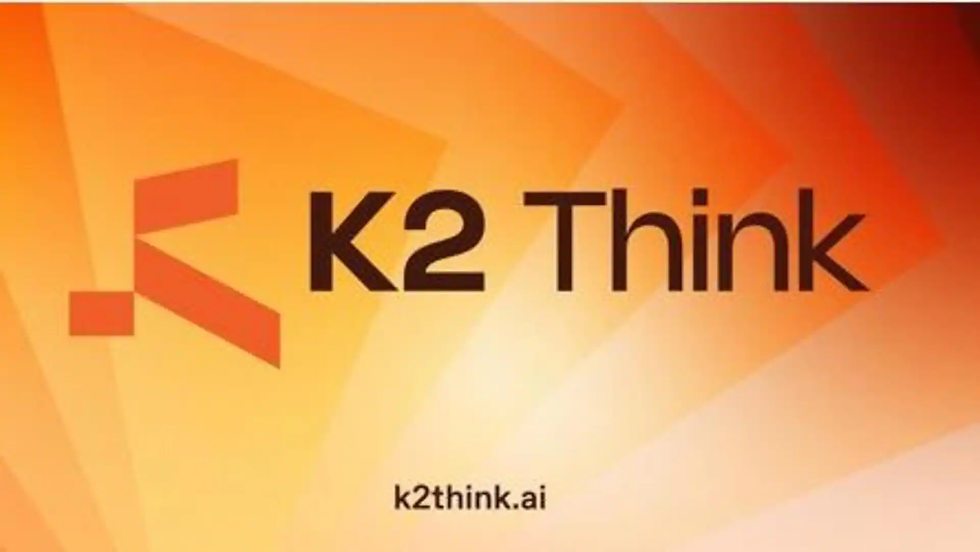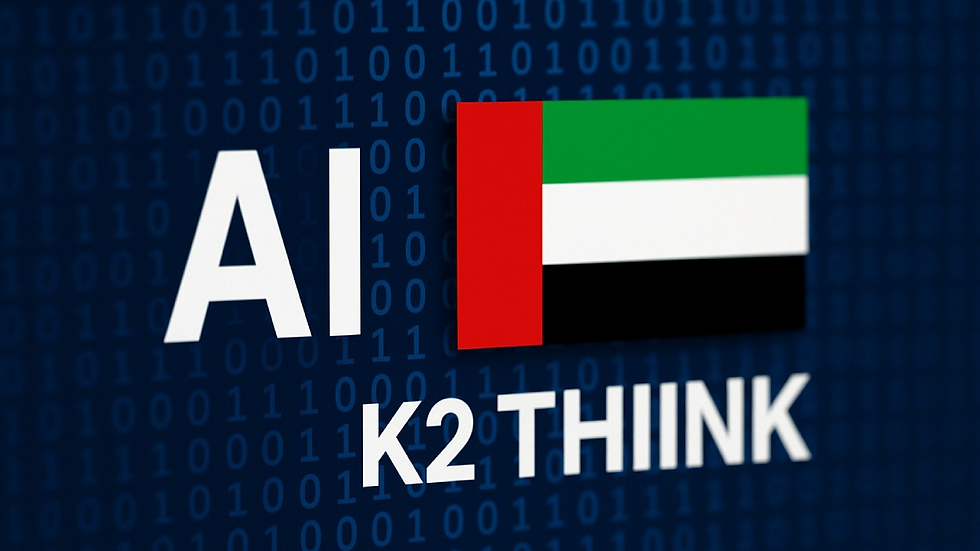UAE Launches K2 Think: A 32B-Parameter Low-Cost Inference Model Achieving 20× Cost-Performance
- Aisha Washington

- Sep 11
- 10 min read

What the K2-Think launch means and why you should pay attention
A national launch with technical ambitions
The United Arab Emirates has publicly unveiled K2‑Think, a 32‑billion‑parameter large language model positioned as a practical, low-cost option for production inference workloads. The K2‑Think research report summarizes the 32B architecture, training regimen, and evaluation sets, while press coverage highlights the move as both a technology milestone and a strategic national initiative backed at the highest levels of government. President Sheikh Mohamed publicly endorsed the platform at launch events, and profiles of the program in international outlets placed the project on the global AI map. TIME’s coverage provides additional context about the organizers and ambitions behind the effort.
Why developers, product leaders, and CIOs should care: K2‑Think claims a reported up-to‑20× improvement in inference cost‑performance versus much larger models, which could materially shift where and how organizations host LLM services. It promises easier deployment options for edge and cloud environments, explicit guidance for precision-aware inference, and a public set of tutorials and documentation for practitioners. For hands-on readers, the project has public tutorials and deployment guides aimed at practical adoption and an accessible research report for deeper technical review.
Key takeaway: K2‑Think is framed as a pragmatic alternative—focusing on deployable efficiency rather than raw scale—to lower the economic barriers to production LLM use.
What K2‑Think offers and how it’s designed for low-cost inference

Engineered for production inference at scale
K2‑Think is marketed primarily for inference efficiency: the team designed the model and serving stack to optimize throughput and reduce per‑token cost for high‑volume applications. The public documentation and report describe tuning choices across model architecture, memory layout, and inference pipeline that together enable the claimed cost‑performance gains. The K2‑Think research report lays out the design choices and optimization strategies.
A few of the practical capabilities emphasized by the launch materials:
Compatibility with lower‑precision formats and quantized runtimes to shrink memory footprint and increase arithmetic throughput.
An inference stack intended for hybrid edge/cloud deployment, including step‑by‑step tutorials for common GPU and embedded scenarios.
Preconfigured integration paths for popular ML serving frameworks so engineers can adopt the model without custom low-level engineering.
Precision, tooling, and developer friendliness
K2‑Think’s documentation encourages precision‑aware serving—using formats like FP8 or aggressive quantization to reduce cost—because these approaches materially change the economics of inference. For context, recent analysis of FP8-based inference quantization shows meaningful reductions in compute and memory costs when models are compatible with that numeric format. The K2‑Think site likewise hosts example pipelines that demonstrate how to trade a small amount of model fidelity for a larger reduction in operational cost.
The project also includes tutorials and deployment guides to reduce friction for developers. Official tutorials and guides are available from the K2‑Think developer portal, covering local testing, cloud deployment, and edge integration. These materials are designed to shorten the path from evaluation to production.
Governance and enterprise reassurance
K2‑Think’s release is explicitly framed inside the UAE’s national AI strategy and compliance apparatus. The messaging around the launch highlights alignment with national AI ethics principles intended to reassure enterprise buyers concerned about governance and regulatory risk; see the UAE’s AI compliance and governance principles. For regulated industries or government procurement in the region, that positioning reduces one non‑technical barrier to adoption.
insight: Positioning an LLM release within an established governance framework can speed procurement cycles and reduce legal risk for enterprise deployments.
Key takeaway: K2‑Think combines engineering for precision‑aware inference with practical tooling and governance posture to target real production workloads rather than research bench benchmarks.
What the model is, how it was evaluated, and where the 20× claim comes from

Core specifications and training overview
At its core, K2‑Think is a dense transformer‑style model with 32 billion parameters. The K2‑Think research report provides a summarized description of the architecture, the datasets used in pretraining and fine‑tuning, and the evaluation sets. The report describes a training regimen tuned for general-purpose instruction following, with additional task‑specific fine‑tuning performed on representative benchmarks used by the authors to assess real‑world inference tasks such as summarization, search reranking, and conversational response quality.
Defining terms for non-specialists: a parameter is a numeric weight in the neural network; larger parameter counts generally increase capacity but also require more memory and compute. Inference is the runtime phase when the model generates outputs given inputs, and cost‑performance is the ratio of useful output (quality and throughput) to the compute cost required to produce it.
Benchmarks, latency, throughput, and the 20× claim
The headline "up to 20× cost‑performance" improvement comes from the authors’ benchmarking of inference latency, throughput (tokens/sec), and cost‑per‑token when K2‑Think is served under optimized runtimes versus larger models served under typical production settings. The research report includes the benchmark methodology and measured comparisons, and press coverage highlights those findings in summarized form. TIME’s profile of the launch offers additional commentary on the reported metrics and their strategic framing.
It is important to parse the claim carefully: "20×" is a comparative figure that depends on the baseline (which larger models are being compared), the hardware used, and the precision settings for both models. For example, a 32B model running in FP8 on a modern GPU, with an optimized batch and CUDA kernel, can reach much higher tokens/sec per dollar than a 200B+ model running in FP16 without quantization. Those differences compound across millions of daily requests.
Comparative context with larger models
To understand where K2‑Think sits in the broader landscape, the report and press juxtapose it with two representative families:
DeepSeek‑V2 (236B) — a very large dense model that prioritizes raw capacity and benchmark performance, useful for tasks that require broad world knowledge or very long context reasoning.
ST‑MoE style sparse expert models (e.g., ST‑MoE 269B) — sparse Mixture of Experts architectures increase parameter counts while only activating a subset of experts per token, trading compute for capacity but adding routing complexity.
K2‑Think trades raw parameter count for a tuned, efficient inference pipeline. Against a dense 236B model, the 32B model will typically have a lower peak quality ceiling on very large or highly nuanced benchmarks but will cost much less to operate for standard production tasks. Compared with MoE-type sparse models, K2‑Think avoids routing instability and serving complexity while delivering predictable latency and simpler scaling.
Cost drivers and how precision choices matter
Inference cost has several components: GPU hours (compute), memory footprint (affecting hardware choice), engineering and ops complexity (serving and scaling), and latency/throughput tradeoffs that affect instance utilization. Lower‑precision formats such as FP8 and aggressive quantization reduce both memory and compute per operation, directly lowering cost. Recent analyses of FP8-based inference quantization show it can materially reduce cost while keeping quality acceptable for many tasks. But gains are workload‑dependent: some tasks (e.g., code generation or sensitive legal summarization) may need higher numeric fidelity.
insight: The real dollar savings depend less on headline parameter counts and more on the deployed precision, batch sizing, and how well the serving stack maps the model to hardware.
Key takeaway: The 20× cost‑performance figure is credible under specific, well-optimized serving conditions and careful precision choices, but real savings depend on your workload, latency requirements, and deployment decisions.
Rollout, pricing, and deployment requirements for K2‑Think

Availability timeline and how to get started
K2‑Think was launched with official events and government endorsements; practical adoption starts with the developer resources published on the project site and the research report for technical evaluation. Developer tutorials and documentation are available at the official K2‑Think portal, and the public research report provides the detailed metrics needed for a rigorous technical evaluation. The official launch was covered and endorsed at the national level, which has helped accelerate enterprise interest, particularly within the region.
Pricing posture and what to expect
The launch messaging emphasizes “low‑cost inference” and the 20× cost‑performance advantage, but the team has not published a universal per‑token price that applies across all deployments. Practical costs will vary according to:
Precision and quantization choices (e.g., FP8 vs FP16).
Cloud provider and instance family (some GPUs have faster kernels for low‑precision math).
Whether you run inference on premise, on edge devices, or in cloud regions with different pricing.
For procurement planning, treat the 20× figure as a directional performance benchmark to guide testing rather than a guaranteed savings figure. Perform workload‑specific pilots to measure real cost per completed query.
Hardware and software guidance
K2‑Think’s documentation recommends inference stacks that support lower‑precision compute and efficient memory layout. Typical recommendations include:
GPUs with optimized FP8 kernels or quantized operators, or specialized inference accelerators that support low‑precision math.
Serving frameworks that allow model sharding, batching, and optimized attention kernels.
Edge deployments for latency‑sensitive workloads where model size and quantization enable running on smaller accelerators.
For edge vs cloud tradeoffs, recent analyses of edge deployment efficiency show that smaller, quantized models can transfer certain high‑volume tasks to local devices while retaining acceptable quality. But edge deployments bring additional constraints—thermal management, intermittent connectivity, and hardware variance—that require engineering attention.
Key takeaway: K2‑Think is designed to be practical across cloud and edge environments, but real cost and performance depend on careful selection of precision, instance type, and serving stack.
Real-world usage and developer impact of K2‑Think
From sandbox to production: developer onboarding and pipelines
K2‑Think ships with practical, example pipelines intended to shorten developer ramp time for both prototyping and production. Tutorials cover:
Local testing on a single GPU with quantized weights.
Cloud deployment templates with autoscaling considerations.
Edge packaging examples for NVIDIA Jetson‑class devices and other accelerators.
Because the model is intentionally smaller than many state‑of‑the‑art large models, developers find it faster to iterate and cheaper to run experiments—factors that accelerate product discovery. Small teams and startups, in particular, can use K2‑Think to validate features like summarization, conversational agents, or vector search without committing to a multi‑million dollar serving bill.
Enterprise scenarios and economic reshaping
For enterprises, K2‑Think’s promise is straightforward: lower inference costs make it economically viable to move more LLM workloads in‑house or to regional cloud providers that meet regulatory and latency requirements. Common use cases that benefit from cost savings include:
High‑volume chatbots and virtual assistants where response latency and cost per session are key metrics.
Document summarization and search reranking for customer support knowledge bases.
Real‑time augmentation of business workflows (e.g., extractive insights from incoming documents).
To quantify impact and risk before a full rollout, organizations can use decision frameworks from the literature. GATE, for example, is a framework for AI automation assessment that helps quantify potential productivity gains, automation impact, and integration risk. Integrating such frameworks with the K2‑Think pilot data will give procurement and compliance teams a credible basis for broader adoption.
Governance, ethics, and regional economic effects
The UAE’s framing of K2‑Think within its national AI ethics strategy matters in practice. Organizations in the Gulf and surrounding regions will likely view the model as a lower‑friction option due to the public alignment with the UAE’s AI compliance principles. That alignment can shorten vendor vetting cycles and encourage public‑sector trials.
At a regional level, a deployable, cost‑efficient model could accelerate localized AI product development—supporting Arabic language capabilities, region‑specific data policies, and sovereign cloud hosting—thereby shifting some workloads away from global hyperscalers. That is particularly true for SMEs that are cost‑sensitive but need reliable, governable AI services.
insight: When model economics permit, organizations prefer to own the stack they can govern rather than rent capacity from distant providers with opaque control.
Key takeaway: K2‑Think’s practical design and governance positioning reduce technical and institutional friction, enabling more organizations to experiment with LLMs in production settings.
FAQ — K2‑Think 32B model: questions developers and buyers are likely to ask

Short practical answers for evaluation and procurement
Q: What does the 20× cost‑performance claim actually mean?
A: It’s a reported improvement in cost per useful inference under the authors’ benchmark conditions, comparing K2‑Think in optimized low‑precision serving against some larger models in standard serving modes. Your mileage will vary by workload and deployment choices; consult the research report for benchmark details.
Q: Can I run K2‑Think at the edge or on commodity GPUs?
A: Yes. Official tutorials show local, cloud, and edge deployment paths, but edge deployments require attention to memory, thermal, and latency constraints.
Q: Does K2‑Think use FP8 or another low‑precision format by default?
A: The project emphasizes precision‑aware inference and supports FP8 and quantization as levers for cost reduction. For technical context on expected gains and tradeoffs, see the FP8 inference cost analysis.
Q: How does K2‑Think’s accuracy compare to 200B+ models?
A: For many production tasks—summarization, FAQ-style conversation, reranking—K2‑Think aims to be competitive. On highly specialized or scale‑sensitive benchmarks, very large models may still yield better raw accuracy.
Q: Is K2‑Think compliant with UAE AI ethics guidelines?
A: The launch is explicitly positioned within national AI governance, and the team highlights compliance with the UAE AI compliance principles. Organizations should still perform their own risk and compliance checks.
Q: How should I validate the model for my use case?
A: Run controlled A/B trials comparing quality metrics (e.g., ROUGE, BLEU, human‑rated fidelity) and cost metrics (tokens/sec, $/1000 tokens) under your target hardware and precision settings; use decision frameworks like GATE to quantify impact.
Q: Where can I find hands‑on resources?
A: Start with the official tutorials and deployment guides and read the research report for reproducibility details.
K2‑Think and the near‑term future of low‑cost inference

A pragmatic direction for production AI
K2‑Think’s public debut crystallizes a broader shift that many engineers and product leaders have seen coming: the race for raw parameter counts is now being tempered by a market that values predictable, low‑cost inference. By emphasizing a 32B architecture tuned for quantized and optimized serving, the project underscores that many business problems—customer chat, search, summarization, and routine automation—do not always require the largest models to hit acceptable quality thresholds.
In the coming years, we are likely to see three interacting trends play out. First, more models will adopt precision‑aware designs and provide official tooling for FP8 and other quantized runtimes, making low‑cost inference the default for many workloads. Second, enterprises will increasingly demand transparent governance and regional hosting options; models that couple technical efficiency with explicit compliance and provenance will have a procurement advantage. Third, incumbents that still prioritize scale will need to justify their higher operating costs with demonstrable gains on specialized tasks or by offering differentiated services that smaller models cannot match.
What readers and organizations can do next
For practitioners curious about adopting K2‑Think, start with a two‑pronged evaluation: (1) measure cost and latency under realistic serving settings using the official tutorials, and (2) measure task‑level quality against a relevant baseline. Use frameworks like GATE for automation assessment and consult the K2‑Think research report for reproducibility details. For executives and procurement teams, consider pilot programs that test whether moving certain inference workloads in‑house produces real cost savings and improves time‑to‑market.
There are uncertainties worth noting. Deployment gains depend on hardware availability and the maturity of low‑precision kernels across cloud providers; quantization can introduce brittle failure modes for some tasks; and geopolitical or regulatory shifts could change where organizations prefer to host services. These are not reasons to pause evaluation—rather, they emphasize the need for measured pilots and governance guardrails.
A directional closing thought
K2‑Think illustrates a practical course correction in the LLM ecosystem: prioritizing efficient, well‑documented, governable models that are easy to deploy. That matters for innovators and pragmatists alike—because lowering the cost of inference makes it possible for more teams to experiment, iterate, and ship AI‑powered experiences that are responsibly governed and economically sustainable. As the next updates arrive and real‑world case studies accumulate, the most valuable insight will be empirical: which workloads migrate successfully to efficient models, and how organizations adapt their engineering and governance practices to capture those savings.


